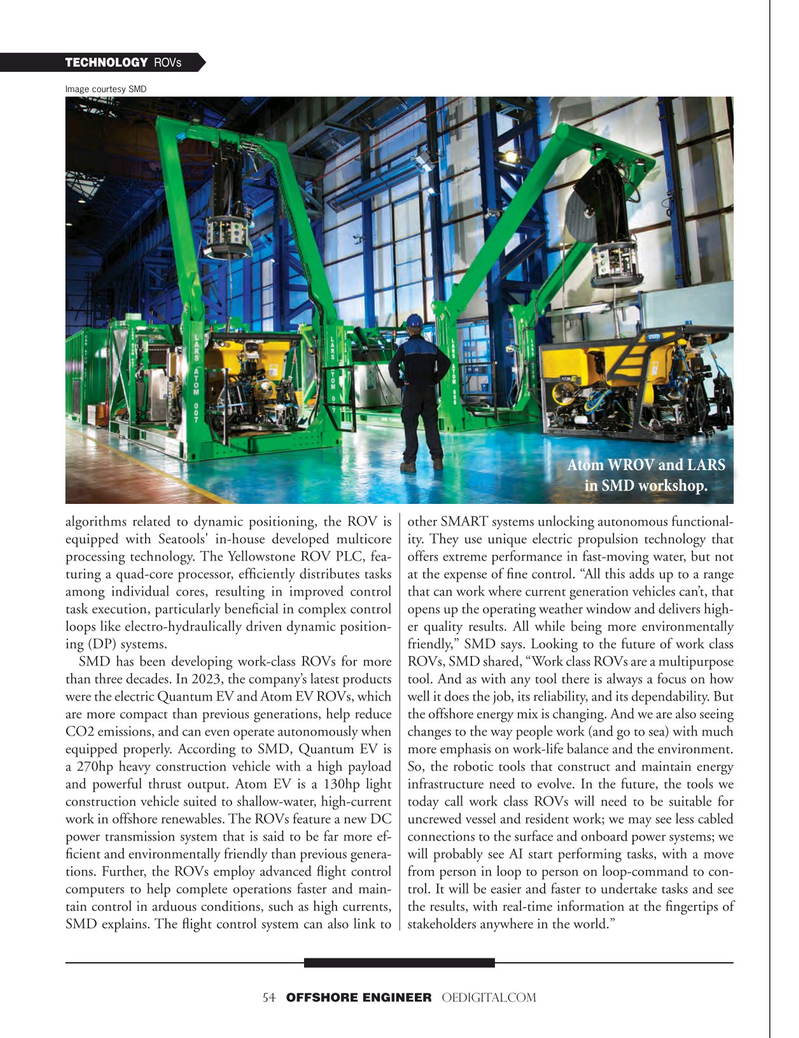
Page 54: of Offshore Engineer Magazine (Jan/Feb 2024)
Read this page in Pdf, Flash or Html5 edition of Jan/Feb 2024 Offshore Engineer Magazine
TECHNOLOGY ROVs
Image courtesy SMD
Atom WROV and LARS in SMD workshop.
algorithms related to dynamic positioning, the ROV is other SMART systems unlocking autonomous functional- equipped with Seatools' in-house developed multicore ity. They use unique electric propulsion technology that processing technology. The Yellowstone ROV PLC, fea- offers extreme performance in fast-moving water, but not turing a quad-core processor, effciently distributes tasks at the expense of fne control. “All this adds up to a range among individual cores, resulting in improved control that can work where current generation vehicles can’t, that task execution, particularly benefcial in complex control opens up the operating weather window and delivers high- loops like electro-hydraulically driven dynamic position- er quality results. All while being more environmentally ing (DP) systems. friendly,” SMD says. Looking to the future of work class
SMD has been developing work-class ROVs for more ROVs, SMD shared, “Work class ROVs are a multipurpose than three decades. In 2023, the company’s latest products tool. And as with any tool there is always a focus on how were the electric Quantum EV and Atom EV ROVs, which well it does the job, its reliability, and its dependability. But are more compact than previous generations, help reduce the offshore energy mix is changing. And we are also seeing
CO2 emissions, and can even operate autonomously when changes to the way people work (and go to sea) with much equipped properly. According to SMD, Quantum EV is more emphasis on work-life balance and the environment. a 270hp heavy construction vehicle with a high payload So, the robotic tools that construct and maintain energy and powerful thrust output. Atom EV is a 130hp light infrastructure need to evolve. In the future, the tools we construction vehicle suited to shallow-water, high-current today call work class ROVs will need to be suitable for work in offshore renewables. The ROVs feature a new DC uncrewed vessel and resident work; we may see less cabled power transmission system that is said to be far more ef- connections to the surface and onboard power systems; we fcient and environmentally friendly than previous genera- will probably see AI start performing tasks, with a move tions. Further, the ROVs employ advanced fight control from person in loop to person on loop-command to con- computers to help complete operations faster and main- trol. It will be easier and faster to undertake tasks and see tain control in arduous conditions, such as high currents, the results, with real-time information at the fngertips of
SMD explains. The fight control system can also link to stakeholders anywhere in the world.” 54 OFFSHORE ENGINEER OEDIGITAL.COM

 53
53

 55
55